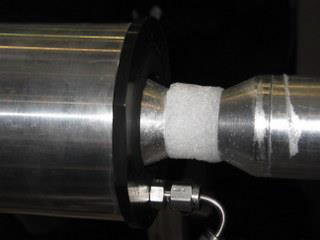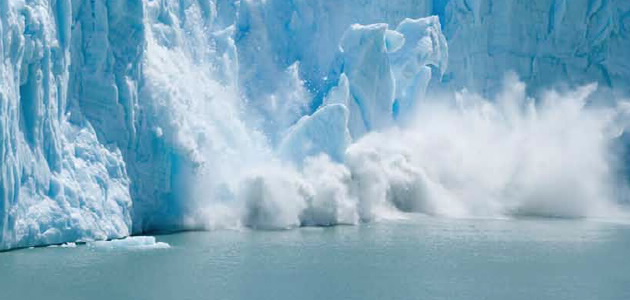Dr Sandra Piazolo from the Department of Earth and Planetary Sciences at Macquarie University, led research at ANSTO to find out how glaciers and ice sheets flow; and how rocks flow at high temperatures and pressures. This Q & A fact sheet provides an insight into the research.
What was the focus of the study?
|
The work at ANSTO is focussed on understanding how crystalline material deforms at high temperatures both on the surface of the earth and its deep interior. We make our own rock-like structure, and then we deform it at ANSTO. We use that information to interpret materials such as glacial ice from Greenland and Antarctica as well as rock that originated from deep in the Earth’s interior, which can be sourced from countries like New Zealand, Greenland and Western Australia.
What we did was to take advantage of the different
facilities available at ANSTO so that we could do experiments with a known sample that had a known composition and grain size and we deformed this to get different types of data which are crucial for our understanding. We look at the orientation of the grains, the size of the grains and the flow behaviour of the sample. We can look at how ice deforms, which has a direct implication on how we understand glaciers and polar caps are moving and with that how the climate may evolve.
| What led you to research ice and ice sheet flows? |
 |
| Scientists preparing a sample for deformation. L-R S. Piazolo, C. Wilson & D. Czaplinska |
The main motivation to work on ice and ice flow is trying to understand what is going on in the heart of mountain belts. A rock is a crystalline material and ice has the same properties so we can use it as an analogue. At the same time, understanding the evolution of ice properties with deformation is crucial for the prediction of climate change as temperature variations will directly impact ice behaviour.
Furthermore, as a geologist, we must overcome one major problem which is that it is simply not possible to watch rocks deform at high temperature and pressure, naturally, as we cannot reach the Earth’s interior. Therefore, we have to resort to accessible rock-like materials like ice in glaciers and ice sheets that we can watch deform in human time scales.
Studying rocks that have once been deformed that were previously deep underground, but are now exposed at the Earth’s surface, can also provide good information about past processes. Deserts are the best places to study this because of the lack of vegetation, but icy deserts in polar-regions like Greenland and Antarctica are also good. I’ve also worked in hot deserts in Turkey and now I’m doing quite a lot of work in New Zealand.
| What was the benefit of using nuclear techniques for this research? |
With neutron diffraction analysis we can analyse the grain size while we are deforming our ice samples. That is a new technique, but the novelty lies in the combination of techniques to produce the maximum amount of information possible.
| How did you feel about using Kowari at the Bragg Institute for the first time? |
When everything is new you have to test it and figure out the best way to do experiments and get data. I think the time investment and what we got out of that investment, worked really well for us. Since I’ve been working at ANSTO, I know much more about what kind of techniques can be useful and I have been involved in several other projects. Learn more about the Kowari instrument.
| What did you learn in this study on Kowari? |
 |
| Experimental set-up used for experiments on Kowari. |
We found that the crystalline material is much more dynamic than we thought it would be.
We could look at all the different data types in real time and trace the behaviour at the resolution of minutes and that is a real first.
| Why is this information important? |
If we understand how ice deforms we can look at ice as it is now and interpret it in terms of past history and events; and if we understand the processes and how those processes changed the ice properties we can predict the past and the future, both of which you need for climate research. We can also look at the chemistry of ice cores and re-construct the climate with that information, but if we don’t know the time scale of how this chemistry came about, then it can be misinterpreted. Looking forward, if we know how things develop and deform, then when it gets warmer, we can predict how the ice will flow and how it will melt and how quickly, of which comes climate implications.
| Why is it important to collaborate with other scientific disciplines? |
I’m collaborating with people who are doing climate models so I can feed them better data so they can make better models.
| What other research questions have arisen out of the study? |
There is one big research question in geosciences which is how does the mantle deform? The mantle is relatively similar to ice in its general properties so from our experiments we can better interpret samples we have from the mantle. We can take a piece of mantle that has come to the surface with a volcanic eruption and we can look at the structure and the material characteristics and better interpret what kind of history it has seen.
| How far into the future will the climate models be able to predict? |
Climate models are good for testing what is possible and not possible. You can test the worst case scenario and the best case scenario. What people try to do is predict between 100 years and a few thousand years and that’s normally sufficient for humanity.
Published: 24/03/2014





